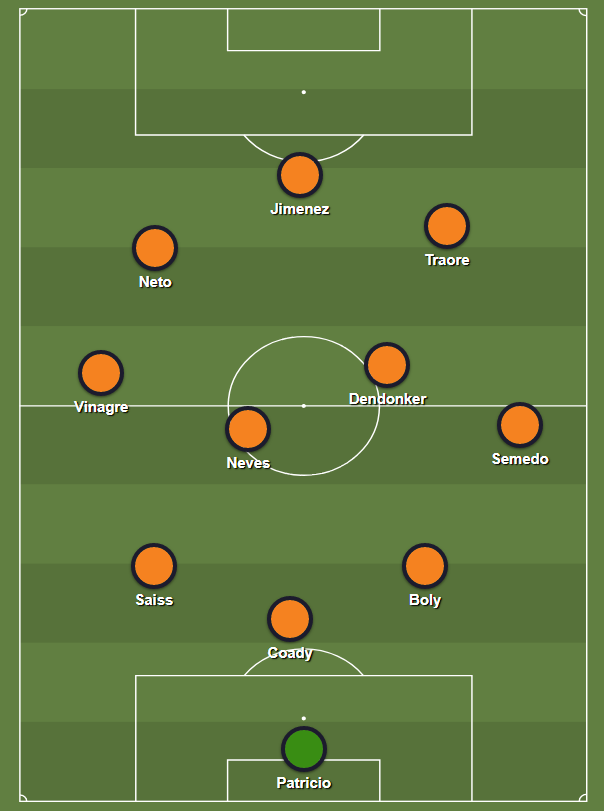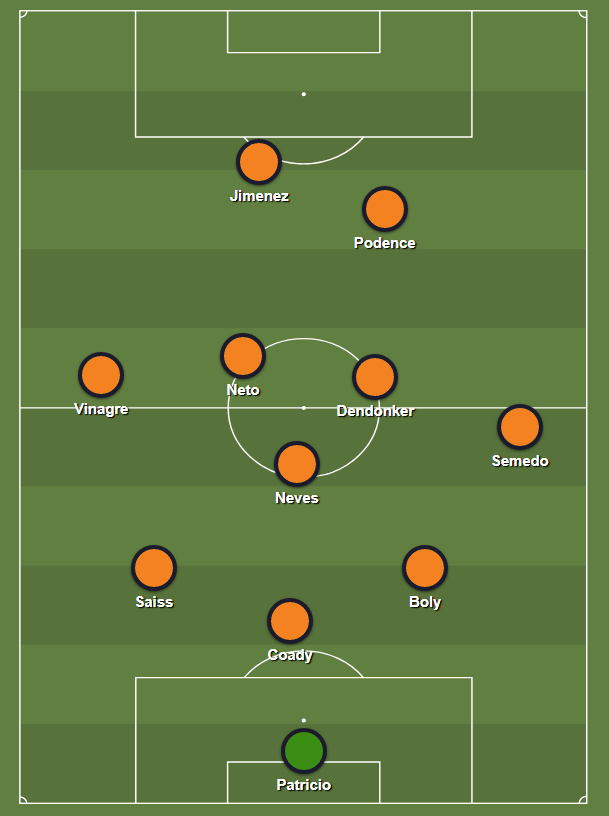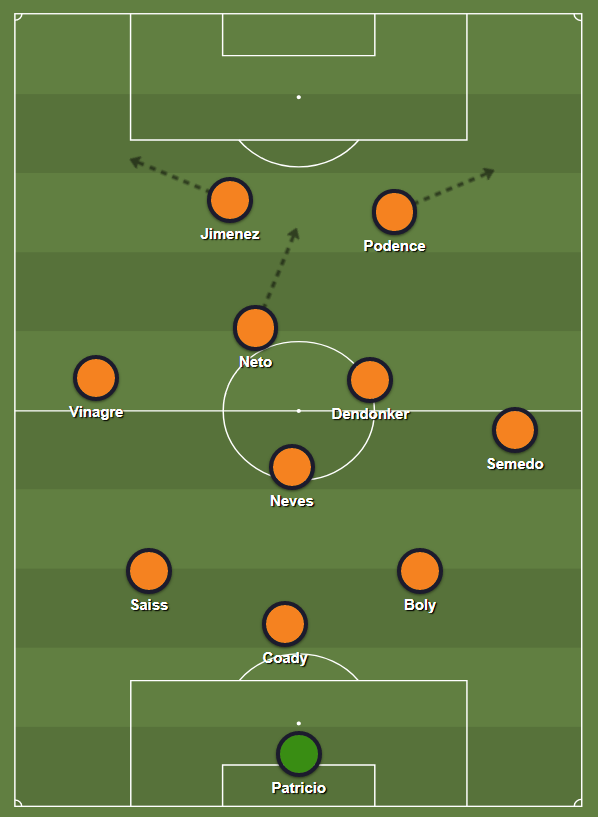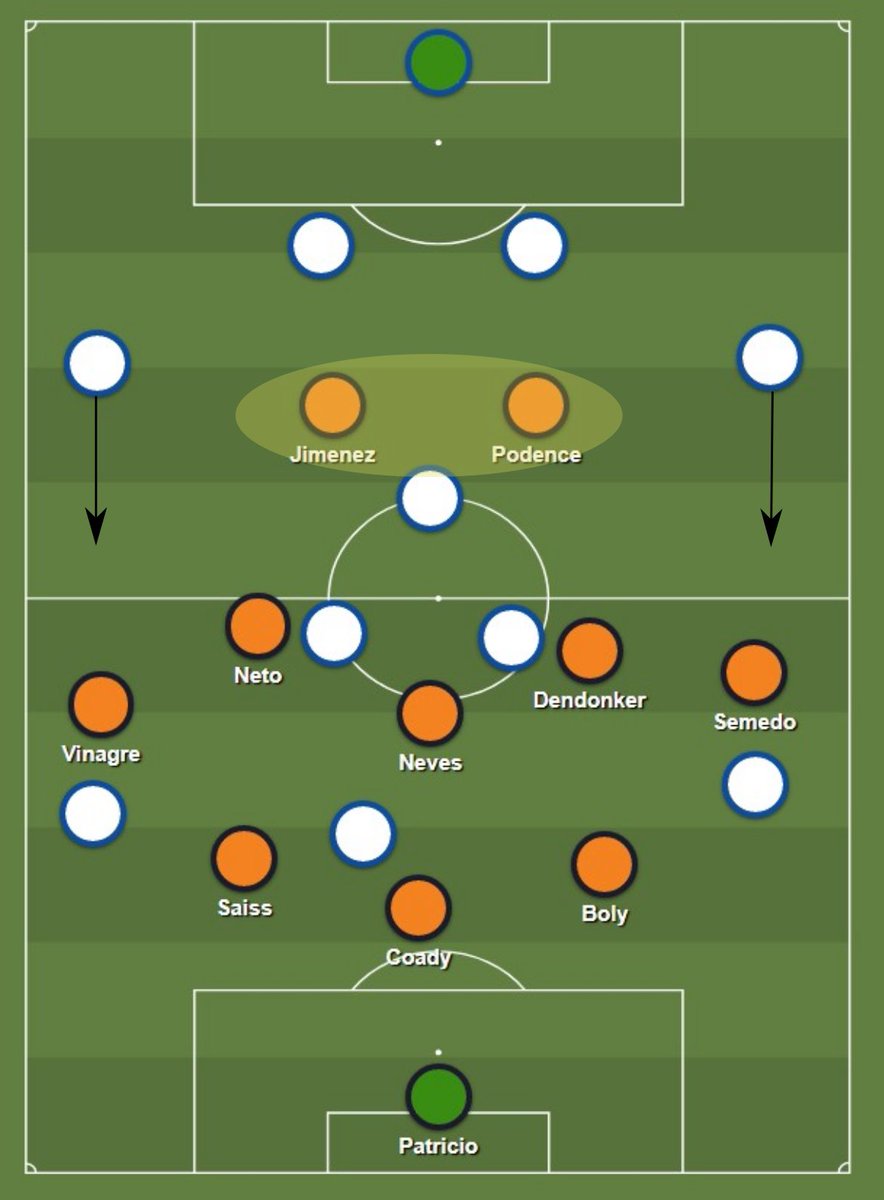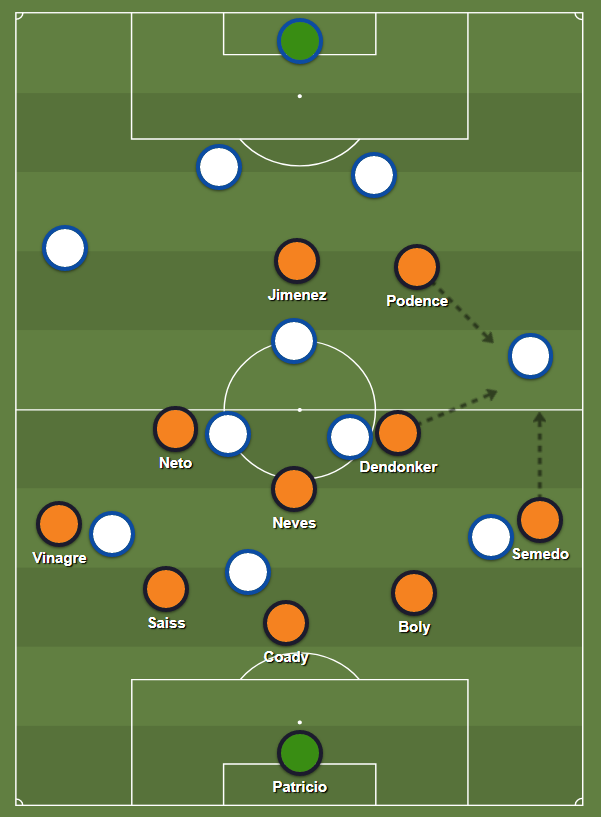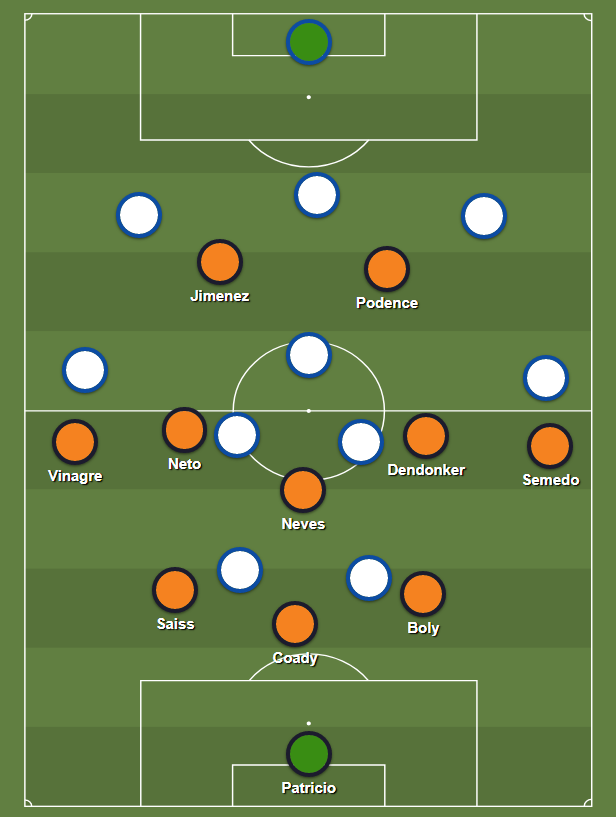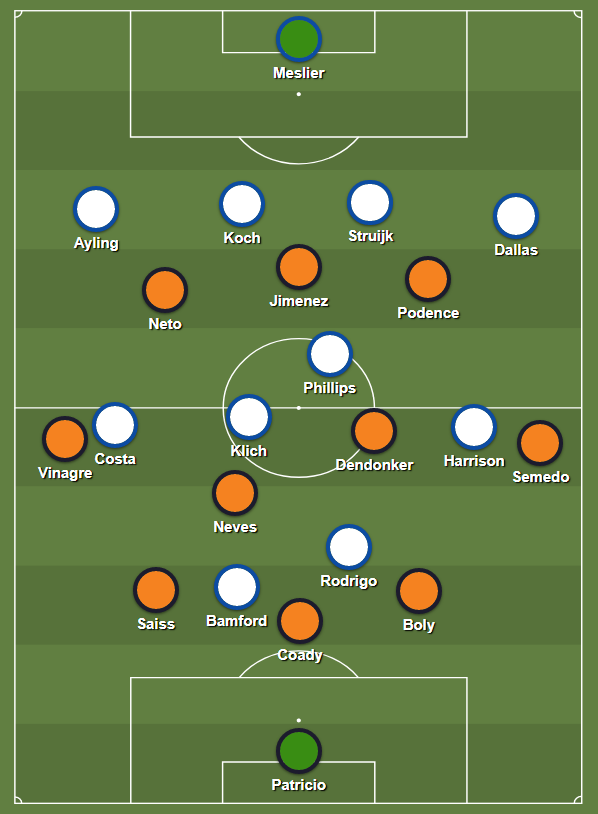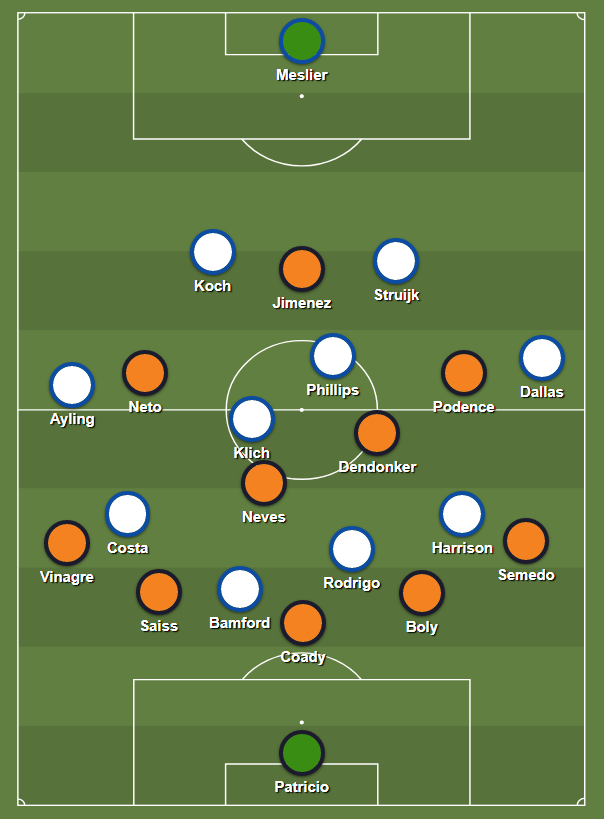Some tactical thoughts ahead of Wolverhampton Wanderer’s visit to Leeds on Monday #lufc: [thread]
In many respects, Wolves are the blueprint for what many Leeds fans want their team to be. Immediate success upon promotion three seasons ago, they prove that recent entry to the Premier League doesn’t have to mean relegation scrapping.
However, stylistically, Wolves are about as dissimilar are you can get from Leeds.
Manager Nuno Espirito Santo has developed a system around a back three (which can become a back five) that forms the basis for a strongly defensive, counter-attacking play-style.
Structurally, Espirito Santo has developed a system which is flexible enough to deal with different opponents. Either he will play with a 3-4-3 or a 3-5-2:
Functionally, in the same way that we see with Leeds shifting between a 4-1-4-1 and a 3-3-1-3 out and in possession, Wolves are able to do something similar with their two structures:
In this instance, one of the two advanced midfielders—Pedro Neto, in this case—is able to carry the ball forward in attack, forming a functional 3-4-3 structure in the attacking phase.
When we’re talking about a 3-4-3 vs a 3-5-2, therefore, we’re talking about the defensive set-up.
For Nuno, it seems as though the determinant for which out-of-possession structure Wolves prefer is based around where they look to build-up or transition.
In the case of the 3-5-2, the system is designed to force teams who move centrally into wide areas where their players can become isolated and turnovers forced.
As you can see, with the two strikers staying relatively centrally out of possession, two things are achieved: firstly, the central midfielder is blocked off, which should stop oppositions playing through the middle of the field.
Secondly, space opens out for the full backs to drive into space. This might seem counter intuitive but Wolves use this space as a way of setting a pressing trap.
With the full back pushing forward, Wolves can block in a unit of three, isolating the ball carrier and, hopefully for them, forcing a turnover:
In this instance, the opposition left back has the ball, drives into space but then finds themselves isolated with the Wolves ball-near striker closing off the passing lane backwards.
In the case of Leeds, Nuno will know that Leeds like to build up in the wide areas and that their close passing will likely be good enough to work through these sorts of pressing traps.
He will also know that Leeds themselves like to leave the central areas fairly open during possession so the extra man in midfield in defensive phases is probably wasted.
On top of this, the last time Leeds did come up against a 3-5-2—against Sheffield United—Bielsa essentially matched the formations: 3-5-2 vs 3-5-2.
Why? Well, we know the principles behind Bielsa’s defensive structure: man-oriented marking which is organised by the +1 rule in defence (a libero or spare player at the back) and the -1 rule in attack (one fewer pressers than there are opponents).
Against a 3-5-2, Bielsa would want two attackers to press the back three, and would require a back three to ensure a man over at the back.
The outside centre back can push out wide and offer an out ball and, with the opposition wing back having to push up onto their opposite number, a lot of space opens out in the wide channels for the ball to be played into.
As a result, expect to see the 3-4-3 played on Monday.
Applying the same structural principles to the 3-4-3 (man-to-man, +1 in defence, -1 in defence), we might actually see something like a 4-4-2 or a 4-4-1-1 in response from Leeds on Monday night:
This season, we’ve already seen Rodrigo and Patrick Bamford working on some 2-vs-3 forward presses. We’ve also seen Rodrigo perform at his best in a more auxilliary striker role, helping link the play between the midfield and Bamford.
In addition, the Wolves front three would be countered by a Leeds back four. All the requirements for off-the-ball structure for Bielsa are met. The 4-4-2 or 4-4-1-1, then, would work quite nicely against a Wolves 3-4-3.
As you can see here, the wide forwards are expected to track the full backs deep and prevent them from causing any problems. This makes Wolves themselves a little bit vulnerable on the counter-attack: something that West Ham exploited well in their recent 4-0 win.
This means that both Helder Costa, Jack Harrison and Raphinha (should he make an appearance) will play an important role on Monday night. If they can lose their wide marker and press onto the Wolves’ wing backs, they could cause all kinds of problems.
So that’s defensively. How will Wolves play offensively?
Where Wolves are very structured out of possession, their attacking play is somewhat less patterned.
We all know how dangerous a marksman Raul Jimenez is and how dangerous a dribbler Adama Traore is.
Wolves’ attacking play, then, is based around attacking transition: can they break up the field out of their defensive structure and leave the opposition in such disarray that they can exploit the spaces that open out.
Obviously, with Liam Cooper out and Stuart Dallas as the player tasked with keeping Traore quiet, there will be a few nervous Leeds fans on Monday.
Of course, Pascal Struijk is more than up to the task of defending against Jimenez. Although the fact that our back up centre backs from here are Luke Ayling (our right back), Kalvin Phillips (our defensive midfielder)
and Oliver Casy or Charlie Cresswell (neither of whom have a senior start between them).
When it comes to Dallas and Traore, the trick here is managing the Spaniard’s efficiency.
There is not (nor probably has there ever been) a better dribbler in world football than Traore. The guy attempts double digit dribbes in a game and completes over 70% of them. That is elite.
Where there is a weakness is in his end product. Of course, that has been slowly improving too over recent seasons. But this is still the best bet to keep him under wraps.
If you can keep him on his weaker foot and in wide areas, you can hope to limit Adama’s efficiency. Dallas is a smart player and Bielsa will have worked the strategy past him.
With those two kept quiet, Leeds will hope to blunt Wolves’ attacking capabilities and give themselves a chance at the other end.
In many respects, this game feels like it could follow a similar trajectory to the Sheffield United game. The Blades are a team who sit back and look to decompress to catch teams out of defensive position.
That said, Wolves will be much more dangerous on the counter than Sheffield United were and so don’t expect an easy ride on Monday.
If you like this in blog form: https://allstatsarentwe.substack.com/p/leeds-united-vs-wolverhampton-wanderers">https://allstatsarentwe.substack.com/p/leeds-u...
Or in audio form: https://pod.fo/e/a1825 ">https://pod.fo/e/a1825&q...
If you like our stuff and want more, why not check out our Patreon page where we have bonus podcasts, written material and analysis videos: http://www.patreon.com/allstatsarentwe ">https://www.patreon.com/allstatsa...
And if you made it this far, share the love (or at least the original tweet in this thread). Thanks!

 Read on Twitter
Read on Twitter